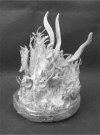Stable Formation of Fruiting Body in Cordyceps bassiana
- PMID: 24015103
- PMCID: PMC3763178
- DOI: 10.4489/MYCO.2007.35.4.230
Stable Formation of Fruiting Body in Cordyceps bassiana
Abstract
In order to breed a Cordyceps bassiana isolate that stably forms fruiting body in artificial cultivation, isolates derived from subculturing and single spores were tested through mating. From C. bassiana EFCC 783, three subcultured isolates EFCC 2830, EFCC 2831 and EFCC 2832 were obtained and fourteen single conidial isolates were obtained from these three subcultured isolates. Two different morphological types were found in the fourteen single conidial isolates. One type was able to form synnemata and another type was not able to form synnemata. Since switch of morphological type was not observed despite their continuous subculturing, cross was performed between the two types and the formation of fruiting body was examined. Ascospores were obtained from a selected fruiting body formed by hybrid of the cross. Self-cross and combinational cross of the ascospore-derived isolates generated hybrids that stably produce high quality fruiting body in artificial media.
Keywords: Cordyceps bassiana; Mating type; Perithecial fruiting bodies; Single conidial isolates; Synnemata.
Figures





Similar articles
-
Selection of Superior Strains of Cordyceps militaris with Enhanced Fruiting Body Productivity.Mycobiology. 2006 Sep;34(3):131-7. doi: 10.4489/MYCO.2006.34.3.131. Epub 2006 Sep 30. Mycobiology. 2006. PMID: 24039486 Free PMC article.
-
Cultural Characteristics and Fruiting Body Production in Cordyceps bassiana.Mycobiology. 2010 Jun;38(2):118-21. doi: 10.4489/MYCO.2010.38.2.118. Epub 2010 Jun 30. Mycobiology. 2010. PMID: 23956638 Free PMC article.
-
Distribution and in vitro Fruiting of Cordyceps militaris in Korea.Mycobiology. 2005 Dec;33(4):178-81. doi: 10.4489/MYCO.2005.33.4.178. Epub 2005 Dec 31. Mycobiology. 2005. PMID: 24049497 Free PMC article.
-
Mating type and mating strategies in Neurospora.Bioessays. 1990 Feb;12(2):53-9. doi: 10.1002/bies.950120202. Bioessays. 1990. PMID: 2140508 Review.
-
A breakthrough in the artificial cultivation of Chinese cordyceps on a large-scale and its impact on science, the economy, and industry.Crit Rev Biotechnol. 2019 Mar;39(2):181-191. doi: 10.1080/07388551.2018.1531820. Epub 2018 Nov 4. Crit Rev Biotechnol. 2019. PMID: 30394122 Review.
Cited by
-
Successful Development of Cordyceps bassiana Stromata from Beauveria bassiana.Mycobiology. 2010 Mar;38(1):13-6. doi: 10.4489/MYCO.2010.38.1.013. Epub 2010 Mar 31. Mycobiology. 2010. PMID: 23956619 Free PMC article.
-
Metabolic profiles and free radical scavenging activity of Cordyceps bassiana fruiting bodies according to developmental stage.PLoS One. 2013 Sep 13;8(9):e73065. doi: 10.1371/journal.pone.0073065. eCollection 2013. PLoS One. 2013. PMID: 24058459 Free PMC article.
-
NMR and GC-MS based metabolic profiling and free-radical scavenging activities of Cordyceps pruinosa mycelia cultivated under different media and light conditions.PLoS One. 2014 Mar 7;9(6):e90823. doi: 10.1371/journal.pone.0090823. eCollection 2014. PLoS One. 2014. PMID: 24608751 Free PMC article.
-
Optimum Conditions for Artificial Fruiting Body Formation of Cordyceps cardinalis.Mycobiology. 2010 Jun;38(2):133-6. doi: 10.4489/MYCO.2010.38.2.133. Epub 2010 Jun 30. Mycobiology. 2010. PMID: 23956641 Free PMC article.
-
Growth and Cultural Characteristics of Ophiocordyceps longissima Collected in Korea.Mycobiology. 2011 Jun;39(2):85-91. doi: 10.4489/MYCO.2011.39.2.085. Epub 2011 Jun 16. Mycobiology. 2011. PMID: 22783082 Free PMC article.
References
-
- Dodge BO. The life history of Ascobolus magnificus: Origin of ascocarp from two strains. Mycologia. 1920;12:115–134.
-
- Edgerton CW. Plus and minus strains in the genus Glomerella. Am J Bot. 1914;1:244–254.
-
- Humber RA. Fungal pathogens and parasites of insects. In: Priest FG, Goodfellow M, editors. Applied Microbial Systematics. Dordrecht: Kluwer Acadenic Publishers; 2000. pp. 203–230.
-
- Kobayasi Y. The genus Cordyceps and its allies. Sci Rept Tokyo Bunrika Daigaku Sect B. 1941;5:53–260.
-
- Kobayasi Y, Shimizu D. Cordyceps species from Japan, 6. Bull Nat Sci Mus. 1983;9:15.
LinkOut - more resources
Full Text Sources
